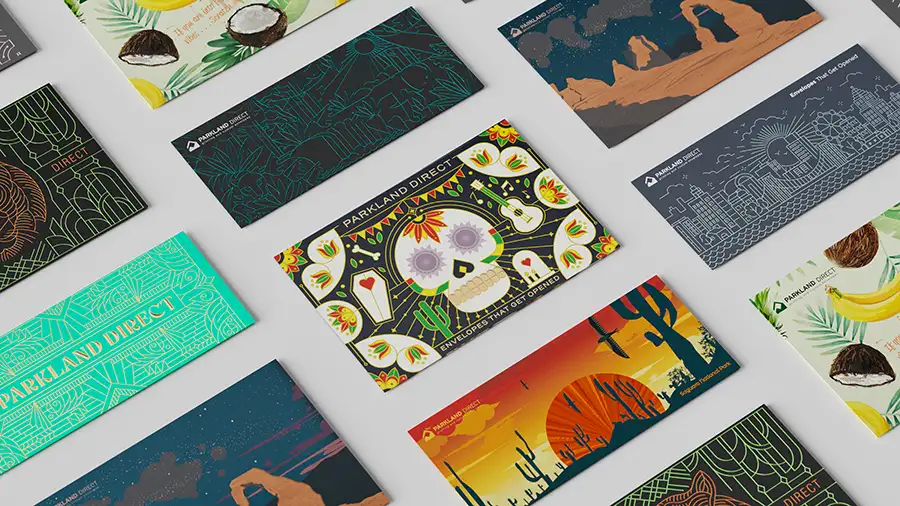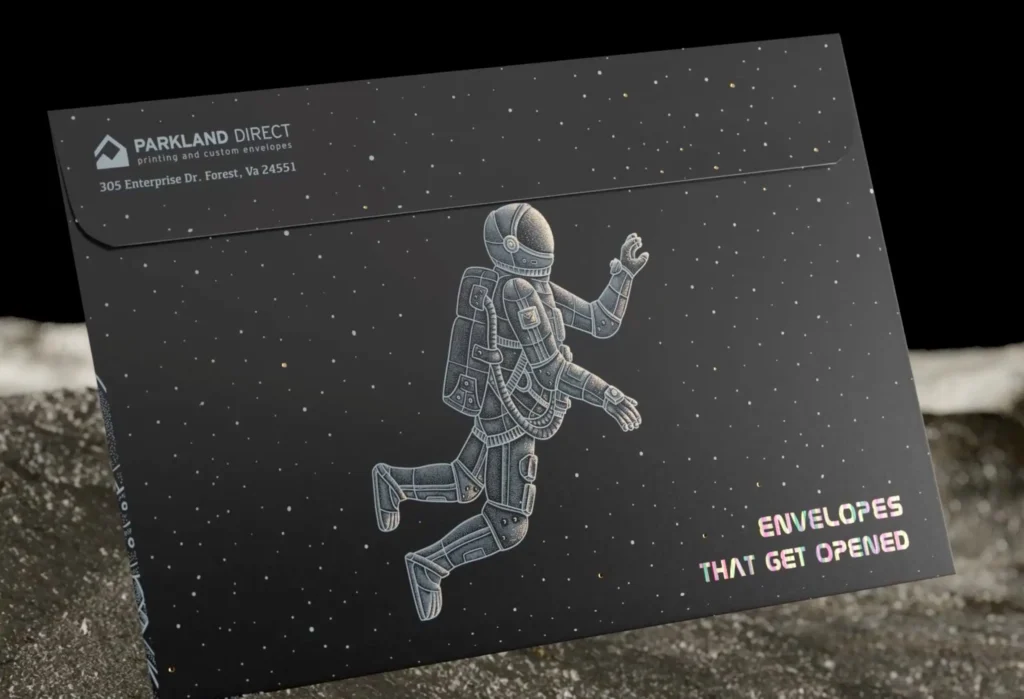
By Julie Shaffer, senior vice president, content and programs, WhatTheyThink/ Association for PRINT Technologies
Brands add embellishments to printed products to make them stand out and to grab the consumer’s attention. Studies show that people will look at a branded product with enhancements, such as foil, 50% longer than without such enhancements. Brands put this to work for many packaged products; consider those rows of beautifully embellished wine and liquor labels on store shelves. But there is a blue ocean of opportunity in a market people may not associate with print embellishment – direct mail marketing – and it is proving to be a boon for the savvy marketers who are using it to stand out in the sea of white envelopes in the consumer’s mailbox.
Certainly, digital communication has had a major impact in reducing many forms of mail, especially billing. A recent study shows that 66% of US consumers pay at least some of their bills electronically directly to the biller and 40% pay bills through their bank’s digital payment service. But while billing mail is on the wane, direct mail marketing brings a brand’s message directly to the consumer’s door.
The US mail market is the largest in the world, with more volume than all the EU countries’ mail volume combined. Approximately 66 billion units of marketing mail are sent each year. In fact, the mailing industry represents about 4.6% of the US GDP. Combine this with the fact that the US is a consumer economy, with 70% of the GDP represented by consumer spending, and it’s the perfect medium to carry a brand’s message to a massive potential audience.
And people do read the direct marketing pieces that show up in their mailboxes. Studies show that US households read or scan over 70% of the advertising mail they receive, a statistic that remains unchanged since 2019. Consumers spend an average of 30 minutes reading their mail, and a USPS report on direct mail found that 67% of respondents agree mail feels more personal than the Internet.
That personal touch is an important component of direct mail marketing. Personalized messaging is nothing new, but today consumers almost have come to expect it. This especially is true for millennials, who have grown up with digital communication and are less concerned with sharing data. As the largest living age group in the US today, millennials are an important marketing target – together with Gen X, they make up 42% of the population.

Contrary to the popular stereotype that digital natives are glued to their digital devices, studies are showing it is millennials who most often interact with direct mail. For example, a recent USPS study looking at how millennials respond to direct mail shows that 80% of millennials look forward to seeing what’s in their mailbox and two-thirds of millennials may bring marketing mail to retail stores or use direct mail prompts to go online.
Still, it can be a challenge for brands to get their direct mail piece to stand out from that stack in the mailbox. And just as brands have found that adding embellishment to packaging helps grab the attention of a shopper, the same is true for direct mail marketing. “If embellishment works in packaging, it can work for direct mail,” said Clint Seckman, president of Parkland Direct, whose company is a leader in high-end, embellished envelope manufacturing.
A big reason embellishments “work” – that is, get people to notice and react to it – has to do with neuroscience. The human brain reacts differently to print than it does to digital media. Over half of the brain is devoted to processing sensory experience, and much of that sensory receptivity focuses on touch. Studies show that people who touch an object, or even imagine touching it, begin to exhibit a sense of ownership. Foil stamping has been shown to significantly affect consumer attention toward a product compared to the same product without foil, and metallized paper envelopes can boost response rates by as much as 30%. Adding a tactile element like texture, or visual enhancers like foil, to a mail piece will make it stand out and stimulate a haptic response.
Parkland Direct has been in the printing business for 45 years and an envelope manufacturer for over 20 years. Just as its high-volume mail clients have shifted from billing mail toward direct marketing mail, so has the company. Parkland’s embellished envelopes business has grown over the past five years and includes many advanced embellishments techniques – metallic foils, holographic foils, embossing, micro-embossing and a range of textures – on the outside of envelopes. Today, Seckman said, the business is, “all about the customer experience.”
Andy Schipke, vice president marketing and strategic sales, W+D North America, the largest supplier of envelope equipment in the mail market, put it this way: “We have moved the envelope away from being simply a delivery device and made it a part of the promotion.” An embellished envelope, he said, can improve lift and open rates; provide a tactile, memorable customer experience; and help tell a brand’s story, all before it is opened. “The challenge,” Schipke said, “has been how to do this at scale for hundreds of millions of units per customer. Companies like Parkland have been leaders in this space.” Mailing technology, he said, also has been changing to accommodate this need.
Two of the largest industries that heavily use direct mail marketing are nonprofits and the financial industry. Because adding embellishments also adds cost to mail pieces, nonprofits are less likely to use it. Financial companies, however, are putting together direct mail campaigns with all sorts of added embellishments to help to position their products as high quality, like high-end packaged products or a fine wine label. While adding embellishments increase the production cost, Seckman said, these brands measure success not in cost per piece, but in cost per customer acquisition.

The USPS is doing its part to help promote physical mail and direct mail response rates through its promotions and incentive programs. These annual programs encourage marketers, printers and mailers to integrate mail with new print techniques and technology for First-Class® and USPS Marketing Mail® with postage discounts. Each promotion runs for about six months, starting at different times of the year. The promotions for 2024 will be the same as 2023, which include discount incentives (typically around 5%) for direct mail projects that utilize personalization, reply mail, Informed Delivery®, retargeting, “emerging technology” and “tactile, sensory and interactive technologies.”
The USPS Informed Delivery program ties physical mail to online campaigns. The postal service, using automated equipment, scans and captures images of each piece of mail. These images are available as a daily preview mail that customers who register for the service can check through email, a mobile app or online dashboard mail before it hits their physical mailbox (so one actually can confirm that the check is, indeed, in the mail.) The Informed Delivery platform also allows marketers to build interactive campaigns around a direct mail marketing piece, providing custom images and URL links along with the image of the mail piece when customers check their daily preview. These links can guide the customer to online content – a video, a web landing page, a storefront – further boosting campaign response rates.
Participation in both Informed Delivery and the promotion and incentive programs is significant. There are over 55 million Informed Delivery customers in the US, and there have been 53,000 marketing campaigns. As for the promotional programs, in 2022, over 22.5 billion mail pieces were mailed as part of the six annual promotions, from over 10,000 direct mailing participants. The program paid $219 million dollars in discounts cumulatively to these marketers.
Carl Boettner is a product development specialist at the USPS and part of the team that manages the promotion and incentive programs. Part of his job is reviewing the samples submitted by marketers for acceptance into the program, and he is a huge proponent of direct mail marketing. “Direct mail cuts through the digital noise,” he said, “and even if a piece of mail that you pull from your mailbox isn’t relevant to you, you’re touching it. You’re interacting with it. That has an impact.”
Schipke agreed. “Marketers are using the science of haptics in whole new ways,” he said. “The customer experience for a lot of marketers begins through tactile nature of a mail piece – whether that be embossing, embellishments or special diecuts – with the understanding that all they have to do is have recipients touch it and feel it and that already will encode in their mind what they want to achieve for the brand. They don’t even necessarily have to read it.”
Perhaps not, but when recipients do open those envelopes, response rates can go through the roof. Seckman said he has clients reporting response upward of 30% for direct mail campaigns in envelopes enhanced with foil or other techniques, a ten-fold increase over the typical direct mail response rate of 2-3%.
Educating brands marketers on print embellishment is key to expanding the opportunities for using it in the mailing industry. The USPS offers a webinar series showcasing interesting direct marketing campaigns and provides how-to educational resources at www.usps.com. Parkland Direct has a creative mailing program and regularly designs and creates new envelopes with different types of embellishments, which then are shared with members of the mailing program (readers can register to be on the recipient list at parklanddirect.com.)
Julie Shaffer is senior vice president, content and programs with WhatTheyThink/ the Association for PRINT Technologies. In a career spanning 35 years, Shaffer has been devoted to building innovative business resources and educational programs to serve the industry. She has developed and presented dozens of educational workshops and presented hundreds of seminars and presentations at major industry events around the world. Shaffer also has authored magazine articles and several industry-focused books, including the PDF Print Production Guide (3 editions), the Web-to-Print Primer and the Social Media Field Guide.
Resources
- “The Flexibility Factor: Mapping Consumer Demand for Bill Payment Innovation,” PYMNTS and BillGo, www.pymnts.com.
- www.census.gov
- www.bea.gov/data/consumer-spending
- www.investopedia.com
- www.usps.com

